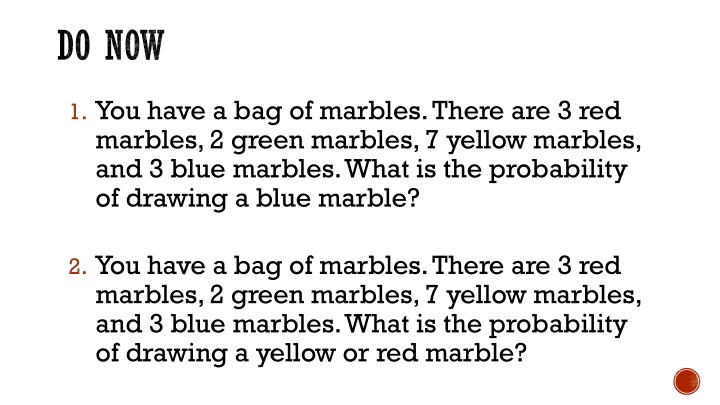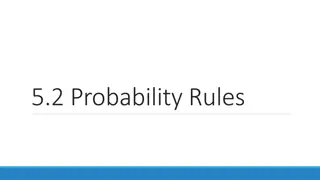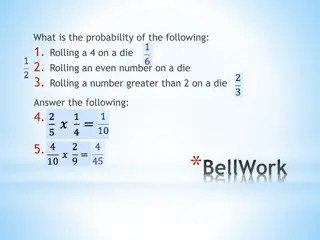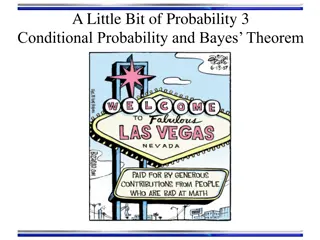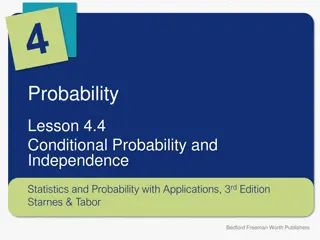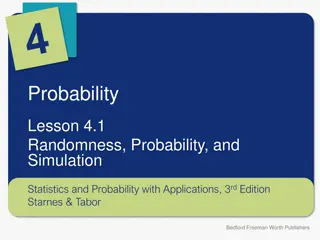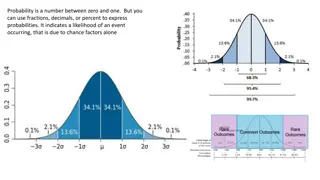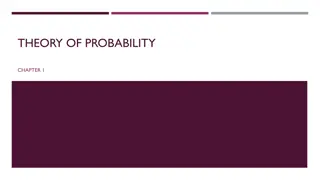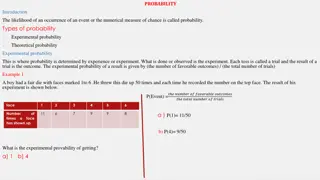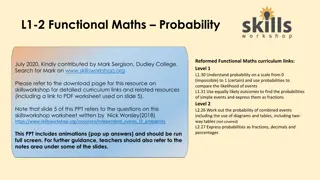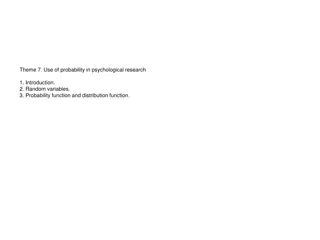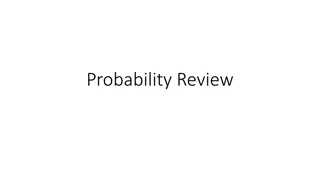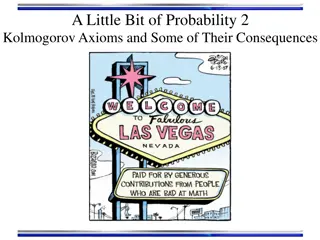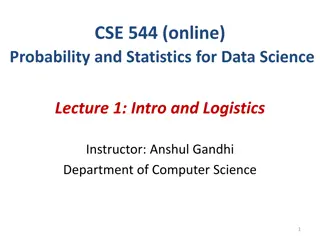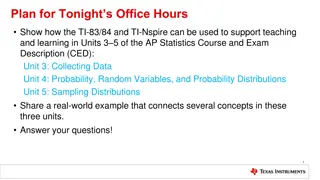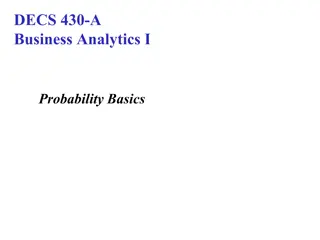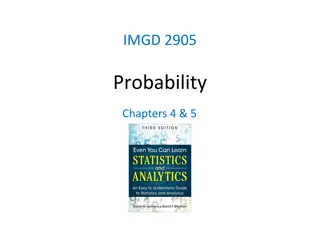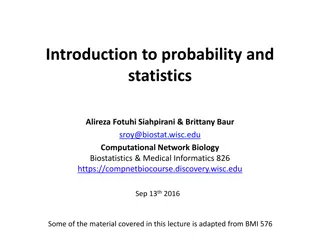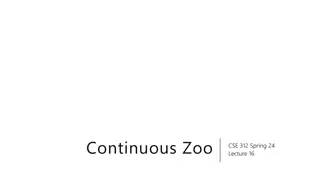Probability Concepts
Probability concepts include classical, empirical, and subjective types, with events, outcomes, and sample spaces defining the likelihood of specific occurrences. Examples and explanations delve into probability calculations using marbles, dice, cards, and more, making intricate concepts relatable and clear through visual aids like tree diagrams.
Download Presentation

Please find below an Image/Link to download the presentation.
The content on the website is provided AS IS for your information and personal use only. It may not be sold, licensed, or shared on other websites without obtaining consent from the author.If you encounter any issues during the download, it is possible that the publisher has removed the file from their server.
You are allowed to download the files provided on this website for personal or commercial use, subject to the condition that they are used lawfully. All files are the property of their respective owners.
The content on the website is provided AS IS for your information and personal use only. It may not be sold, licensed, or shared on other websites without obtaining consent from the author.
E N D
Presentation Transcript
DO NOW 1. You have a bag of marbles. There are 3 red marbles, 2 green marbles, 7 yellow marbles, and 3 blue marbles. What is the probability of drawing a blue marble? 2. You have a bag of marbles. There are 3 red marbles, 2 green marbles, 7 yellow marbles, and 3 blue marbles. What is the probability of drawing a yellow or red marble?
PROBABILITY AND COUNTING RULES
BASIC CONCEPTS Probability the chance of an event occurring Probability experiments a chance process that leads to well-defined results called outcomes Outcome the result of a single trial of a probability experiment
BASIC CONCEPTS Sample Space the set of all possible outcomes of a probability experiment Experiment Toss one coin Roll a dice Answer a true/false question Toss two coins Sample Space Head, Tail 1, 2, 3, 4, 5, 6 True, False Head-head, Head-Tail, Tail-head, Tail-tail
EXAMPLES Find the sample space for: Rolling two die Drawing one card from an ordinary deck of cards The gender of children if a family has three children Use a tree diagram to help! Tree diagram a device consisting of line segments emanating from a starting point and also from the outcome point; used to determine all possible outcomes of a probability experiment
BASIC CONCEPTS Event a set of outcomes of a probability experiment What is the probability of this event happening? An event can be one outcome or more than one outcome What is the probability of having two boys and a girl if you have three children? What is the probability of rolling a 6 on a die? Simple Event an event with one outcome Rolling a 6 on a die (1 outcome) Compound Event an event with more than one outcome Rolling an odd number (3 outcomes)
TYPES OF PROBABILITY 1.Classical 2.Empirical or Relative Frequency 3.Subjective
CLASSICAL PROBABILITY Uses sample spaces to determine the numerical probability that an event will happen You do not have to perform an experiment to determine the probability Assumes all outcomes in the sample space are equally likely!!! Equally likely events events that have the same probability of occurring Rolling 1-6 on a die Flipping heads or tail on a coin
CLASSICAL PROBABILITY Formula for Classical Probability ?????? ?? ???????? ?? ????? ????? ?????? ?? ???????? ?? ?????? ????? This probability is denoted by ? ? =?(?) ?(?) This probability is called classical probability, and it uses the sample space S. Probabilities can be expressed as fractions, decimals, or percentages.
EXAMPLES 1. Probability of picking a Jack out of a deck of cards 2. Probability of picking the 6 of clubs 3. Probability of picking a 3 or a diamond 4. Probability of picking a 3 or a 6
FOUR BASIC PROBABILITY RULES 1. Probability Rule 1: The probability of any event E is a number (either a fraction or decimal) between and including 0 and 1. This is denoted by 0 P(E) 1 3. Probability Rule 3: If an event E is certain, then the probability of E is 1. 4. Probability Rule 4: The sum of the probabilities of all the outcomes in the sample space is 1. 2. Probability Rule 2: If an event E cannot occur (i.e., the event contains no members in the sample space), its probability is 0.
COMPLEMENTARY EVENTS The complement of an event is the set of outcomes in the sample space that are not included in the outcomes of event E. The complement of E is denoted by (read E bar ). The complement of rolling of 4 would be rolling a 1, 2, 3, 5, or 6. Rule for Complementary Events P( ) = 1 P(E) P(E) = 1 P( ) P(E) + P( ) = 1
VENN DIAGRAMS FOR PROBABILITIES P(E) P(E) P( ) P(S) = 1 (b) P( ) = 1 P(E) (a) Simple Probability
EMPIRICAL PROBABILITY The difference between classical probability and empirical probability is that classical probability assumes that certain outcomes are equally likely, while empirical probability relies on actual experience to determine the likelihood of outcomes. Classical: Empirical: 50 people traveled home for Thanksgiving in the following ways: Method Drive Fly Train/Bus There is a 1 in 6 chance of rolling a 2. Frequency 41 6 3 50 So any given person has a 41/50 chance of driving home for Thanksgiving.
FORMULA FOR EMPIRICAL PROBABILITY Given a frequency distribution, the probability of an event being in a given class is ????????? ??? ? ? ????? ????? ????????? ?? ? ? ????????????=? ? ? = ? This probability is called empirical probability and is based on observation.
EXAMPLES In the travel survey, find the probability that a person will travel by airplane over Thanksgiving holiday. Method Drive Fly Train/Bus Frequency 41 6 3 50 In a sample of 50 people, 21 had type O blood, 22 had type A blood, 5 had type B blood, and 2 had type AB blood. Find the following probabilities: A person has type O A person has type A or type B A person has neither type A or type B A person does not have type AB blood Type O A B AB Frequency 21 22 5 2 50
LAW OF LARGE NUMBERS When a probability experiment is repeated a large number of times, the relative frequency probability of an outcome will approach its theoretical probability For example, when a coin is tossed one time, the probability of getting a head is 1/2. But what happens when the coin is tossed 50 times? Will it come up heads 25 times? Not all the time. You should expect about 25 heads if the coin is fair. But due to the chance variation, 25 heads will not occur most of the time.
SUBJECTIVE PROBABILITY Uses a probability value based on an educated guess of estimate, employing opinions and inexact information. For example, a sportswriter from NY may say there is a 70% chance that the Giants will win the Super Bowl A physician might say that, on the basis of her diagnosis, there is a 30% chance the patient will need an operation.
WHAT DO YOU THINK? Assume you are at a carnival and decide to play a game where you have to guess which side of a coin will be facing up after it is tossed. Answer the following questions about the game: 1. What is the sample space? 2. What are the possible outcomes? 3. What does the classical approach to probability say about computing probabilities for this type of problem? You decide to bet on heads, believing that it has a 50% chance of coming up. A friend of yours, who has been playing the game for a while before you stepped up, tells you that heads has come up the last 9 times. You remember the Law of Large Numbers. 4. What is the law of large numbers and does it change your thoughts about what will occur on the next toss? 5. What does the empirical approach say about this problem, and could you use it to solve this problem? 6. Can subjective probabilities be used to help solve this problem?
THE ADDITION RULES FOR PROBABILITY At a large political gathering, you might wish to know, for a person selected at random, the probability that the person is female or is Republican. At the same event, there are Republicans, Democrats, and Independents. If a person is selected at random, what is the probability that the person is Democrat or Republican? What is the difference between these two scenarios? In the first event, a person can be both female and Republican. In the second, a person cannot be both Democrat and Independent. Mutually exclusive events two events that cannot occur at the same time (have no outcomes in common)
THE ADDITION RULES FOR PROBABILITY Addition Rule 1 When two events A and B are mutually exclusive, the probability that a or b will occur is P (A or B) = P(A) +P(B) Addition Rule 2 When two events A and B are not mutually exclusive, then P(A or B) = P(A) + P(B) P(A and B)
EXAMPLES A box contains 3 glazed donuts, 4 jelly donuts, and 5 chocolate donuts. If a person selects a donut at random, find the probability that it is either glazed or chocolate. In a hospital unit there are 8 nurses and 5 physicians; 7 nurses and 3 physicians are male. If a staff person is selected, find the probability that the subject is a nurse or a female. 1. 2.
THE MULTIPLICATION RULES FOR PROBABILITY Independent Events Dependent Events Two events A and B are independent if the fact that A occurs does not affect the probability of B occurring. When the outcome or occurrence of the first event affects the outcome or occurrence of the second event in such a way that the probability is changed, the events are dependent.
THE MULTIPLICATION RULES FOR PROBABILITY The conditional probability of an event B in relationship to an event A is the probability that event B occurs after event A has already occurred. Denoted P(B|A) ? ? ? =?(? ??? ?) ?(?)
THE MULTIPLICATION RULES FOR PROBABILITY Multiplication Rule 1 When two events are independent, the probability of both occurring is P(A and B) = P(A) x P(B) Multiplication Rule 2 When two events are dependent, the probability of both occurring is P(A and B) = P(A) x P(B|A)
EXAMPLES An urn contained 3 red balls, 2 blue balls, and 5 white balls. A ball is selected and its color is noted. Then it is replaced. A second ball is selected and its color is noted. Find the probability of each of these: Selecting 2 blue balls Selecting 1 blue ball and 1 white ball Selecting 1 red ball and then 1 blue ball 1. At a university in western PA, there were 5 burglaries reported in 2003, 16 in 2004, and 32 in 2005. If a researcher wishes to select at random two burglaries to further investigate, find the probability that both will have occurred in 2004. 2. a. b. c.
EXAMPLES A recent survey asked 100 people if they thought women in the armed forces should be permitted to participate in combat. The results are shown. 3. Gender Male Female Total Yes 32 8 40 No 18 42 60 Total 50 50 100 Find these probabilities: a. The respondent answered yes, given that the respondent was female. b. The respondent was a male, given that the respondent answered no.
PROBABILITIES FOR AT LEAST The multiplication rules can be used with the complementary event rule to simplify solving probabilities problems involving at least . Example 1: A game is played by drawing 4 cards from an ordinary deck and replacing each card after it is drawn. Find the probability that at least 1 ace is drawn Example 2: A coin is tossed 5 times. Find the probability of getting at least 1 tail.
WHAT ABOUT THIS? In July 1964, an elderly woman was mugged in Costa Mesa, CA. In the vicinity of the crime a tall, bearded man sat waiting in a yellow car. Shortly after the crime was committed, a young, tall woman wearing blonde hair in a ponytail, was seen running from the scene of the crime and getting into the car, which sped off. The police broadcast a description of the suspected muggers. Soon afterward, a couple fitting the description was arrested and convicted of the crime. Although the evidence in this case was largely circumstantial, the two people arrested were nonetheless convicted of the crime. The prosecutor based his entire case on basic probability theory, showing the unlikeness of another couple being in that area while having all the same characteristics that the elderly woman described.
WHAT ABOUT THIS? (CONTINUED) The following probabilities were used: Characteristic Drives yellow car Assumed Probability 1 out of 12 Man over 6 feet tall 1 out of 10 Man wearing tennis shoes 1 out of 4 Man with beard 1 out of 11 Woman with blonde hair 1 out of 3 Woman with hair in ponytail 1 out of 13 Woman over 6 feet tall 1 out of 100
WHAT ABOUT THIS? (CONTINUED) 1. Compute the probability of another couple being in that area with the same characteristics. 2. Would you use the addition or multiplication rule? Why? 3. Are the characteristics independent or dependent? 4. How are the computations affected by the assumption of independence or dependence? 5. Should any court case be based solely on probabilities?
